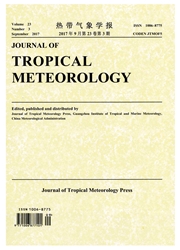

 中文摘要:
中文摘要:
用 1 的真实分析数据 ? 巬??
 英文摘要:
英文摘要:
Using real analysis data of 1°× 1° resolution of the National Center for Environmental Prediction/National Center for Atmospheric Research (NCEP/NCAR), the nondivergent wind component and irrotational wind component obtained by the harmonic-cosine(H-C) method, and the wind structure of Typhoon Fung-Wong (coded 0808 in China) in 2008 was analyzed. The results indicated that the irrotational component was advantageous over the total wind in reflecting both the changes in convergent height and the asymmetrical convergence of Fung-Wong. In Fung-Wong, the nondivergent component was larger than the irrotational component, but the latter was much more variable than the former, which was obtained only from the wind partition method. Further analyses on the irrotational component demonstrated that the location of the convergent center at lower levels was almost the same as the divergent center during the development of Fung-Wong, and its convergent level was high in its life cycle, with the most highest up to 400 hPa when it became stronger. After the typhoon landed in the provinces of Taiwan and Fujian, respectively, its convergent center at lower levels was slowly detached from the divergent center at high levels and the convergent height was also depressed from high levels to lower levels. Gradually, this weakened the intensity of Fung-Wong. This kind of weakening was slow and Fung-Wong maintained its circulation for a long time over land because of its very thick convergent height. Analyses on wind partitioning provided one possible explanation to why Fung-Wong stayed for a long time after it landed. Furthermore, the asymmetric vertical ascending motion was induced by the asymmetric convergence at lower levels. In general, when typhoons (such as Fung-Wong) land, the rainfall region coincides with that of the convergence region (indicated by the irrotational component at lower layers). This means that the possible rainfall regions may be diagnosed from the convergent area of the irrotational comp
 同期刊论文项目
同期刊论文项目
 同项目期刊论文
同项目期刊论文
 Precipitation equations and their applications to the analysis of diurnal variation of tropical ocea
Precipitation equations and their applications to the analysis of diurnal variation of tropical ocea 期刊信息
期刊信息
